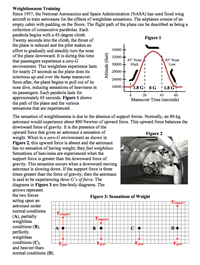 Weightlessness Training
Weightlessness Training
Resource:
The Science Reasoning Center: Weightlessness Training
Grade Level: High School
Description:
This passage presents information regarding NASA's effort to train astronauts to become accustomed to weightless sensations. Information is presented in the form of a graph, a photo and a diagram. Questions target a student's ability to interpret a graph and a diagram in light of a body of text, to select data values from a graph, to identify conclusions that are consistent with a model, and to translate information from one graph to another graph.
Performance Expectation:
HS-PS2-1 Analyze data to support the claim that Newton’s second law of motion describes the mathematical relationship among the net force on a macroscopic object, its mass, and its acceleration.
This activity aligns with the three dimensions of the Next Generation Science Standards in the manner described below:
| Forces and Motion (HS-PS2.A.1): Newton's 2nd Law accurately predicts changes in the motion of macroscopic objects. |
Creating a weightless environment means that one is experiencing a free fall scenario in which only the force of gravity is acting. As four free body diagrams are used to describe four segments of this NASA training aircraft’s flight path, one can qualitatively predict how the astronaut’s motion will be affected during each period. Segment “C” illustrates the weightless situation that is the desired environment for training these astronauts. |
| Cause and Effect: Systems can be designed to cause a desired effect. |
Whether it be to shoot a movie clip of actors pretending to be astronauts experiencing zero G’s or to train real astronauts in such an environment, this passage describes how NASA uses aircraft to create this desired zero G effect. While this passage communicates that this technique can simulate weightlessness over a relatively short period of time (~25 seconds), this plane accurately models how astronauts experience the same effect as when inside an orbiting spacecraft. |
| Analyzing and Interpreting Data: Analyze data in order to make valid and reliable scientific claims or determine an optimal design solution. |
Analyzing and interpreting data through graphs, pictures, and diagrams trains the reader to compare and combine data that is presented in several different formats. This passage includes all these data representations. The first several questions at the conclusion of this passage require students to use this data to make a claim regarding when astronauts will begin to experience weightlessness, how long will it occurs, and where in the plane’s flight path the astronaut feel the zero G environment. |
| Developing and Using Models: Use a model to predict the relationships between systems or between components of a system. |
Scientists use models to predict how humans will respond to unfamiliar environments. Scientists model the zero G environments in order to study its effects on astronauts and to provide training for those who will live in such an environment for extended periods of time. In this passage, students will also use the simulation data to predict what these astronauts will experience. |
| Constructing Explanations and Designing Solutions: Apply scientific principles and evidence to provide an explanation of phenomena and solve design problems, taking into account possible unanticipated effects. |
Questions at the close of this passage such as “What is the cause of the zero G environment created inside the plane during the parabolic maneuver?” and “Why does NASA fly their astronauts on these dramatic parabolic maneuvers?” ask students to construct explanations. As they do, students will need to apply scientific principles that they have learned from experience or within this passage to provide their evidence-based explanation. |
Associated Reading from The Physics Classroom
Other Supporting Pages at The Physics Classroom:
View Infographic.
(Coming Soon)
Search the NGSS Corner
Maybe you're looking for something really specific that pertains to a desired topic and emphasizes one or more of the listed NGSS dimensions. Why not try a search of this section of our website? Simply select from one or more of the pull-down menus and click Search This page will reload and a collection of possibilities will be displayed in this section of the page and sorted by relevancy.